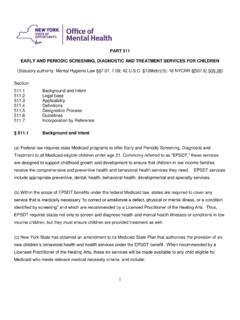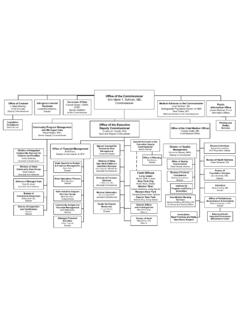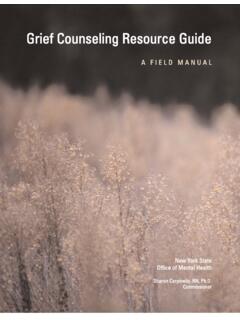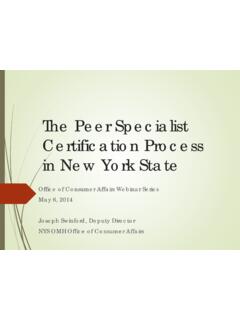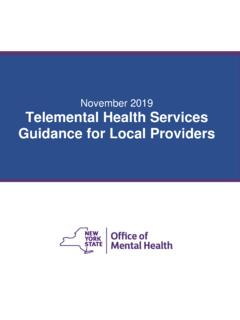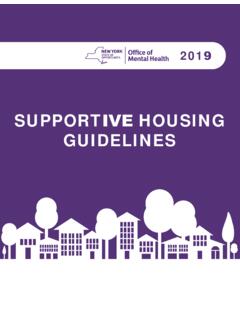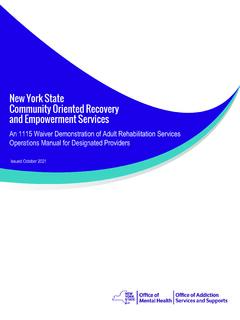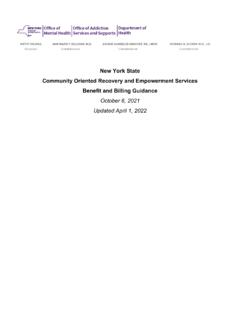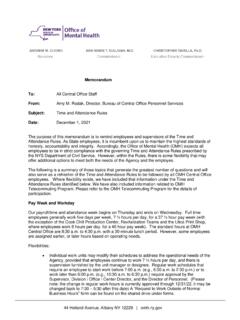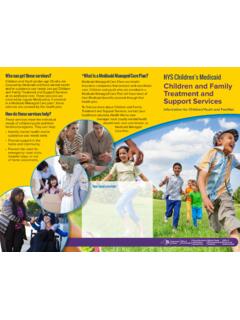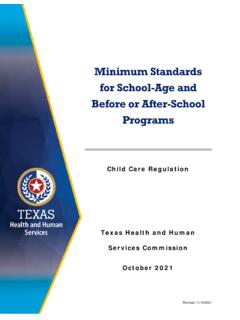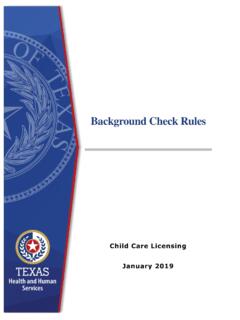Transcription of Adult, Child and Youth Service Dollar Guidance - OMH ACT ...
1 Adult, Child and Youth OMH Care Management and ACT State Aid Guidance Service Dollars 2740. Assertive Community Treatment Service Dollars 8810. Flexible Recipient Service Dollars (Non-Medicaid Programs) 1230. Re-issued September 2021. Introduction Starting in 2012, the Office of Mental Health's (OMH) Medicaid funded Adult Targeted Case Management (TCM) program transitioned to the Health Home (HH) program administered by the Department of Health (DOH). Child and Youth TCM transitioned to the Health Home Serving Children ( hhsc ) program in December of 2016. In this document, TCM programs previously licensed by OMH will be referred to as Legacy providers. The Care Management and Assertive Community Treatment (ACT) programs are intended to assist individuals in developing and maintaining situations for living, working and socializing in the community which enhances their potential for growth and independence.
2 To support this initiative, the OMH continues to provide State Aid in the form of Service Dollars (2740, 8810 & 1230)1 for Adults with Serious Mental Illness (SMI) and Children up to the age of 21 with Serious Emotional Disturbance (SED). The Guidance below outlines the expectations related to the use of Service Dollars and subsequent reporting requirements. Population Service Dollars may be used for Adults with a SMI and Children under the age of 21 with SED. currently enrolled with a Legacy provider, Specialty Mental Health Care Management Agency (SMH. CMA), or ACT Team. This would include special populations such as non-Medicaid individuals, as well as those receiving Assisted Outpatient Treatment (AOT) or Health Home Plus (HH+) services. Funding State Aid is provided by OMH via contract with the Local Government Units (LGUs).
3 The OMH. distributes State Aid funding to include Service Dollars - to the LGU with a yearly State Aid Letter. LGUs will allocate the Service Dollar funds to the Legacy Providers, Specialty Mental Health Care Management Agency (SMH CMA), and ACT Teams accordingly. 1230, 2740 & 8810 are the funding codes for State Aid Service Dollars as per the Consolidated Fiscal Report (CFR) Manual 1. 44 Holland Avenue, Albany NY 12229 | Guidelines for Use of Service Dollars Many services are available through the Local Department of Social Services (DSS), Medicaid or community agencies. Therefore, all efforts should be made to access these alternate resources first. If alternate resources are not available to meet the needs of the individuals, then Service Dollars may be expended. All Service Dollars should be used in a cost-effective manner to address priority needs for eligible clients.
4 The individual should play a significant role in the planning for and the utilization of Service Dollars. For Child and Youth care management, the Child / Youth /family should be involved in the planning of Service Dollars. The two options to expend Service Dollars include: Emergency Purchases: Emergency Purchases are intended to address the immediate needs of the individuals served. This may occur when the individual's safety is at risk and no other resources exist. These needs are generally brief and are not anticipated. The use of Service dollars for emergency purchases is short-term and not intended to be ongoing. Some examples include but not limited to: Food/Meals: When faced with a loss/reduction of benefits, Service Dollars can be used to cover the cost of food-related expenses.
5 This may include meals, groceries, or other necessary food items. This cannot be used for any alcoholic beverages. Lodging/Respite/Hotel: Money to secure emergency shelter when the individual is faced with homelessness. Utilities: When an individual receives a Service termination notice, Service Dollars can be used when services are shut off or threatened to be terminated. This may include utilities related to electricity and heat. All efforts should be made by the individual to schedule a repayment plan first with the utility company prior to using Service Dollars. Medical Care: Costs related to the purchase of emergency medical care services, medical supplies, medications, emergency transportation, dental care, and crisis respite services not otherwise covered by Medicaid/insurance.
6 Client-Specific Services: Client-Specific Services are characterized as those needs which can be anticipated. Therefore, they should be associated with the 44 Holland Avenue, Albany NY 12229 | individual's recovery goals and documented in the Plan of Care. Some examples include but not limited to: Medical: Costs related to medical expenses not otherwise covered by insurance. Examples may include pill organizers, co-pays, medical equipment, gym memberships, counseling ( anger management, sex offender treatment not traditionally covered by insurance), and nutritional services. Housing: Expenses related to securing or maintaining the individual's housing. This may include a security deposit, first month's rent, and moving expenses. Education: Assistance with the costs towards educational/training programs and supplies associated with the individual's educational needs.
7 Vocational: Purchases related to the individual's vocational needs. This may include training programs, uniforms, and alarm clocks. Home Repairs/Hardware: Costs associated with maintaining a safe/therapeutic living environment and is outside the obligation of a landlord if individual resides in a rental property. An example would include hardware to address mobility needs. Hygiene Supports: Costs related to maintaining hygiene. This would include haircuts and personal care products. Clothing: Purchases related to seasonal clothing, clothing repair or cleaning. Transportation Assistance: The cost associated with securing transportation to non-medical appointments. This may include bus passes, gas cards, car repairs, and taxi vouchers. Furnishings: Costs of home furnishings such as furniture, appliances, linen, dishes, bedding, and air conditioners.
8 Child Care: For costs associated with Child -care if the individual is attending classes, vocational training, medical or other appointments related to the goals in their Plan of Care. 44 Holland Avenue, Albany NY 12229 | Socialization: Costs related to the promotion of the individual's socialization goals as outlined in the Plan of Care. Some examples would include activities to support community integration, building relationships, culturally based community services, and resources used to pursue hobbies/interests. Family Activities: Expenses related to activities that promote family wellness. Child / Youth Recreational Activities: Costs used to purchase beneficial recreational activities that may contribute to the improvement of the Child 's/ Youth 's physical or emotional well-being.
9 Examples would include fees associated with joining a baseball team or gym. Child / Youth Development Goals: Costs used to further Youth development goals, such as memberships, music lessons, art supplies, summer camps and other activities to further the Child / Youth 's interest or skill sets. The care manager must make every effort to see if scholarships or other financial assistance is available to the Child for any Youth development activities before using Service Dollars. The use of Service Dollars should be clearly documented in the individual's record. The documentation should reflect the need of the individual along with the amount of Service Dollars expended. Reporting Requirements and Monitoring LGUs will continue to report Service Dollars allocated through the State Aid Letter on the County Allocation Tracker (CAT).
10 Legacy providers, Specialty Mental Health Care Management Agency (SMH CMA), LGUs who manage Service Dollars on behalf of State Psychiatric Center Care Management providers, and ACT teams, will report actual Service Dollar expenditures on the Consolidated Claim Report (CCR). Further Service Dollar reporting for program purposes to follow. LGUs and Legacy Providers, Specialty Mental Health Care Management Agency (SMH. CMA), and ACT teams who receive State Aid should have monitoring and management procedures in place for the tracking and appropriate use of this funding and assuring that individuals with behavioral health needs are being served. LGUs are also required to notify the regional OMH Field Office regarding any significant fiscal or programmatic 44 Holland Avenue, Albany NY 12229 | problems as they become known.
